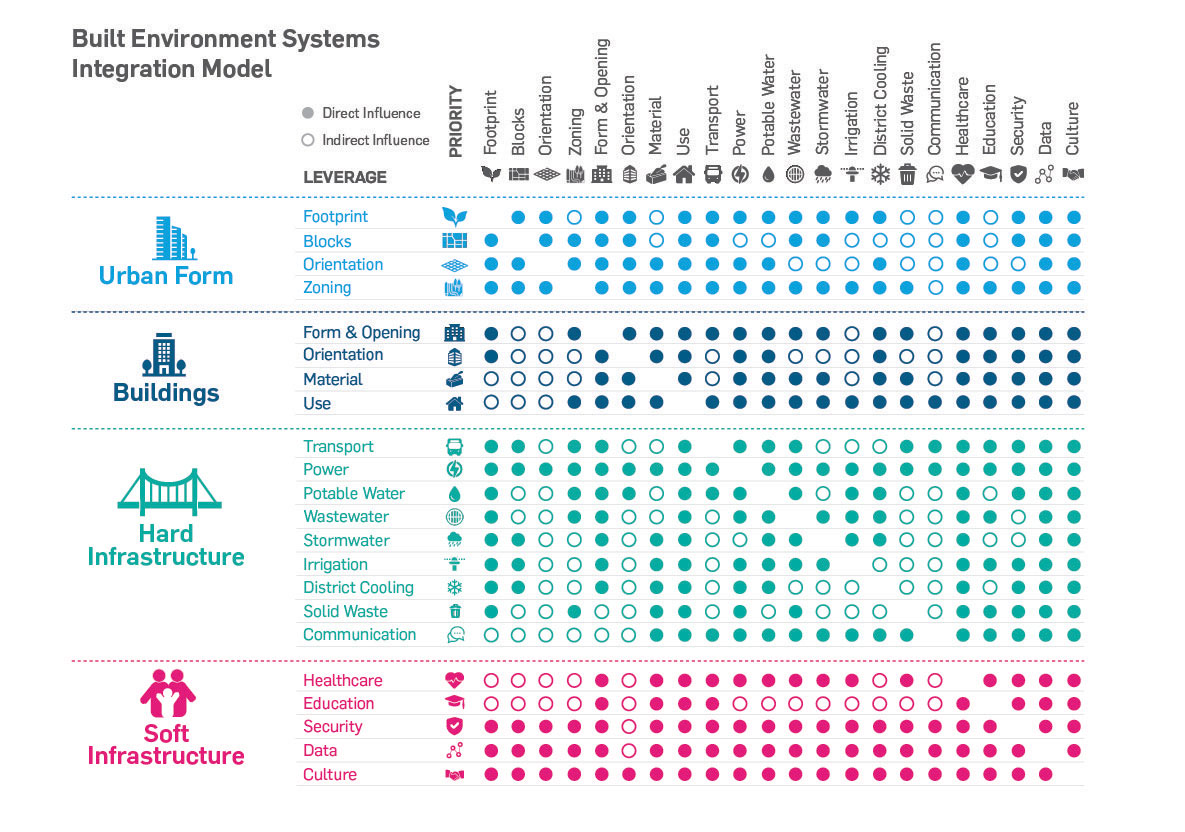-
Markets
Buildings & places
Power & renewables

Rony Hobeika
Associate Principal, Urban Planning & Design, Middle East & Africa, Dubai, United Arab Emirates contact form+971 4 405 9300
The ‘Sustainable City’ is not just a place. It is an idea, an ambition that all new developments aspire to achieve.
As urban planners work to meet sustainability targets within scarcity conditions, they are faced with challenges related to identifying priorities to solve in the design of superstructures and infrastructures. But most often prioritization becomes arbitrary due to the lack of systematic communication between key stakeholders, which in turn leads to missed opportunities in finding synergies. Thus, a roadmap is needed to inform decisions and manage systems influences that together shape a more sustainable city.
Systems thinking can be one such guide. It establishes that we live in a complex world of interdependencies. Systems design suggests a pragmatic and dynamic approach to development, one that analyses a system’s constituent parts and how their intra-relationships influence each other. Development thus is recognized as being a force of change that can have systematic and multi-sectoral effects, and accounting for these ‘ripple effects’ is particularly important when development opts for sustainability targets such as circularity and zero-waste design.
Systems thinking in the built environment
To design sustainable cities, systems thinking can be an effective framework to evaluate integrations in the built environment. Encompassing the entire spectrum of man-made developments, the built environment is composed of Superstructures and Infrastructures. By applying systems thinking, the first can be broken down into sub-components of Urban Form defined by key elements, such as urban footprint, street orientations, and zoning. Buildings is another system that in turn can have a multitude of subsystems as structures and materials.
Infrastructures, on the other hand, are two broad types: Hard Infrastructures like transport, power, and water, and Social Infrastructures like healthcare, education, and security. By cross-referencing different sub-systems, as shown in an exemplary matrix of systems integration model for the built environment (figure1), planners can visually map types of system interactions. They can then decide which targets are a priority, find leverage systems, and engineer solutions in a way that reduces resource consumption and increases reliance on renewable resources. Net-Zero condition will be achieved only when parity is struck between decreasing demand for resource inputs and their supply from renewables.

Figure 1: Matrix of systems integration model for the built environment, Source: AtkinsRéalis
Planning Manhattan Island
Take Manhattan for example. Compact development is one major priority for the island due to land scarcity. So how does the city manage a population density of 28,000 persons per square kilometre? By applying a systems-based approach, planners can identify a handful of levers that can have disproportionate impact on efficient land management. For one, high density construction allowances and mixed-use zoning, strategies known to control sprawl, support more activities and people on ever smaller footprints. Further, to counter overcrowding, the city employs the longest subway network in North America (more than 1,000 km) as well as human-scale urban blocks (250 by 900 feet), together serving to enable walkability and ease traffic congestions. Well-developed healthcare systems can counteract the spread of diseases potentially resulting from intensified human interactions. And to retain its liveability, cultural systems in the form of arts, design, media, and fashion help ensure Manhattan remains a prime attraction for urban living despite being one of the densest places on Earth.
Hydrating Riyadh City
Water scarcity is a notorious challenge for Riyadh. The city relies almost exclusively on desalinated water, an energy intensive and unsustainable resource. Identified as a priority sustainability problem, several high-impact systems can be leveraged to reduce water consumption levels and tap into renewables. For instance, since network leakages are one cause of water losses (up to 1 trillion gallons of water annually by US-EPA estimations), the densification of the city fabric can substantially control them. Also, since residential, commercial, and public buildings are responsible for almost 60% of all water consumption, eco-efficient building designs and high-efficiency fixtures are very effective in cutting demand. Hard infrastructure systems like irrigation networks can utilize recycled water as an alternative and digitalization through smart sensors and metering can manage usage by monitoring and predicting trends. Finally, soft systems, such as education and training, can raise awareness on the environmental costs of water supply networks, and behavioural changes can go a long way in achieving net-zero water targets.
Powering the UAE
Solar power is the most promising alternative energy source in sun-drenched UAE. Photovoltaics’ carbon footprint is estimated to be 20x less than a typical coal-powered plant. However, by employing systems thinking, potential to create further environmental savings across many other sectors can be unlocked. Sustainable transport is one example. Utility-scale plants can speed up the conversion of all fuel-based vehicles, responsible for 30% of total global carbon emissions, to electric ones that emit 40-85% less carbon in total lifecycle. Consuming about 75% of all power in the UAE, buildings can also offer synergetic opportunities. Not only can private residences host different scales of photovoltaic panels, but by orienting structures towards optimal solar and wind conditions and installing low U-value insulation envelopes, resulting lower heat gains and losses can save up to 15% in energy demand. Finally, savings in healthcare spending can be expected due to the reduction in air pollution and the improvement in urban air quality.

Standard practicing systems thinking
One legacy that greatly damaged our societies is the linear mindset of most development that took place in the last centuries. This ‘siloed’ approach gradually disrupted natural environmental processes and delicate balances, climate change being only the latest episode. We now know how to design better. For one, we have learned that development is a complex enterprise whose multi-faceted and interdependent nature demands we sensibly and thoroughly assess the full impact of our design decisions before executing them. Second, we have been developing cutting-edge technologies to help us better predict such effects and fine-tune our approaches to create lower development footprints. We will probably never reach the ideal state of a ‘Sustainable City’, but by adopting systems thinking as a standard practice, we can start to solve one problem at a time: Lowering baseline demand and meeting supply from renewables. By doing that, gradually but systematically, compounded solutions become more solid foundations for the construction of stronger and more resilient environments for ourselves and future generations.
This article was first published in Construction Week in March 2023.
Please note that you are now leaving the AtkinsRéalis website (legal name: AtkinsRéalis Group inc.) and entering a website maintained by a third party (the "External Website") and that you do so at your own risk.
AtkinsRéalis has no control over the External Website, any data or other content contained therein or any additional linked websites. The link to the External Website is provided for convenience purposes only. By clicking "Accept" you acknowledge and agree that AtkinsRéalis is not responsible, and does not accept or assume any responsibility or liability whatsoever for the data protection policy, the content, the data or the technical operation of the External Website and/or any linked websites and that AtkinsRéalis is not liable for the terms and conditions (or terms of use) of the External Website. Further, you acknowledge and agree that you assume all risks resulting from entering and/or using the External Website and/or any linked websites.
BY ENTERING THE EXTERNAL WEBSITE, YOU ALSO ACKNOWLEDGE AND AGREE THAT YOU COMPLETELY AND IRREVOCABLY WAIVE ANY AND ALL RIGHTS AND CLAIMS AGAINST ATKINSRÉALIS, AND RELEASE, DISCHARGE, INDEMNIFY AND HOLD HARMLESS ATKINSRÉALIS, ITS OFFICERS, EMPLOYEES, DIRECTORS AND AGENTS FROM ANY AND ALL LIABILITY INCLUDING BUT NOT LIMITED TO LIABILITY FOR LOSS, DAMAGES, EXPENSES AND COSTS ARISING OUT OF OR IN CONNECTION WITH ENTERING AND/OR USING THE EXTERNAL WEBSITE AND/OR ANY LINKED WEBSITES AND ANY DATA AND/OR CONTENT CONTAINED THEREIN.
Such waiver and release specifically includes, without limitation, any and all rights and claims pertaining to reliance on the data or content of the External Website, or claims pertaining to the processing of personal data, including but not limited to any rights under any applicable data protection statute. You also recognize by clicking “Accept” that the terms of this disclaimer are reasonable.
The information provided by Virtua Research cited herein is provided “as is” and “as available” without warranty of any kind. Use of any Virtua Research data is at a user’s own risk and Virtua Research disclaims any liability for use of the Virtua Research data. Although the information is obtained or compiled from reliable sources Virtua Research neither can nor does guarantee or make any representation or warranty, either express or implied, as to the accuracy, validity, sequence, timeliness, completeness or continued availability of any information or data, including third-party content, made available herein. In no event shall Virtua Research be liable for any decision made or action or inaction taken in reliance on any information or data, including third-party content. Virtua Research further explicitly disclaims, to the fullest extent permitted by applicable law, any warranty of any kind, whether express or implied, including warranties of merchantability, fitness for a particular purpose and non-infringement.
The consensus estimate provided by Virtua Research is based on estimates, forecasts and predictions made by third party financial analysts, as described above. It is not prepared based on information provided by AtkinsRéalis and can only be seen as a consensus view on AtkinsRéalis' possible future results from an outside perspective. AtkinsRéalis has not provided input on these forecasts, except by referring to past publicly disclosed information. AtkinsRéalis does not accept any responsibility for the quality or accuracy of any individual or average of forecasts or estimates. This web page contains forward-looking statements based on current assumptions and forecasts made by third parties. Various known and unknown risks, uncertainties and other factors could lead to material differences between AtkinsRéalis' actual future results, financial situation, development or performance, and the estimates given here.
Downloads
Trade releases
